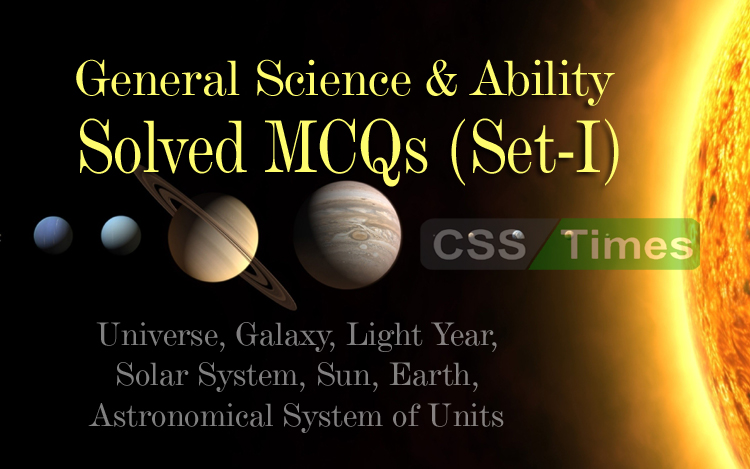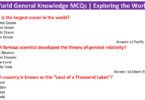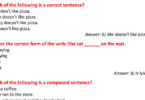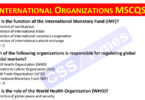Everyday Science MCQs
Universe, Galaxy, Light Year, Solar System, Sun, Earth, Astronomical System of Units
1) The biggest planet in our solar system is (CSS 2013)
(a) Venus
(b) Pluto
(c) Jupiter
(d) None of these
Answer: (c)
In terms of mass, volume, and surface area, Jupiter is the biggest planet in our Solar System by a wide margin.
Size and Mass:
Jupiter’s mass, volume, surface area and mean circumference are 1.8981 x 1027 kg, 1.43128 x 1015 km3, 6.1419 x 1010 km2, and 4.39264 x 105 km respectively. To put that in perspective, Jupiter diameter is roughly 11 times that of Earth, and 2.5 the mass of all the other planets in the Solar System combined.
2) The universe is ———-. (CSS 1996)
(a) Stationary
(b) Expanding
(c) Contracting
(d) None of these
Answer: (b)
In June 2016, NASA and ESA scientists reported that the universe was found to be expanding 5% to 9% faster than thought earlier, based on studies using the Hubble Space Telescope
3) The atmosphere of moon consists of: (CSS 2013) | Everyday Science MCQs
(a) . 90% Hydrogen, 10% Nitrogen
(b) . 80%Nitrogen, 20% Hydrogen
(c) 60% Nitrogen, 40%inert gases
(d) None of these
Answer: (d)
The Moon has no atmosphere. None. That’s why astronauts have to wear their spacesuits when they get outside of their spacecraft on the surface of the Moon.
Atmosphere of the Moon might be electro statically levitated moon dust. These tiny particles are constantly leaping up and down off the surface of the Moon.
4) Who gave the first evidence of the Big- Bang theory? | Everyday Science MCQs
(a) Edwin Hubble
(b) Albert Einstein
(c) S. Chandrasekhar
(d) Stephen Hawking
Answer: (a)
The Hubble Space Telescope was named after astronomer Edwin Powell Hubble (1889–1953), who made some of the most important discoveries in modern astronomy. Dr. Hubble determined that the farther a galaxy is from Earth, the faster it appears to move away. This notion of an “expanding” universe formed the basis of the Big Bang theory, which states that the universe began with an intense burst of energy at a single moment in time — and has been expanding ever since.
5) Which one of the following planets has largest number of natural satellites or moons? | Everyday Science MCQs | Everyday Science MCQs
(a) Jupiter
(b) Mars
(c) Saturn
(d) Venus
Answer: (a)
In the Solar System, there are 179 satellites. A majority of those moons belong to the planet of Jupiter, the second most belonging to Saturn.
Check Also English Grammar MCQs
6) Which of the following planets rotates clock wise? | Everyday Science MCQs
(a) Mars
(b) Jupiter
(c) Venus
(d) Mercury
Answer: (c)
Venus is the only planet that rotates clockwise. Venus (radius 3,760.4 miles) is similar to Earth (radius 3,963.19 miles) in size and structure but spins very slowly; a day on Venus is 243 Earth days long.
7) Which of the following order is given to the planets of solar system on the basis of their sizes? | Everyday Science MCQs
(a) Jupiter, Saturn, Uranus, Neptune
(b) Saturn, Jupiter, Mercury, Earth
(c) Mercury, Earth, Jupiter, Saturn
(d) Earth, Mercury, Saturn, Jupiter
Answer: (a)
Jupiter (69,911 km / 43,441 miles) – 1,120% the size of Earth
Saturn (58,232 km / 36,184 miles) – 945% the size of Earth
Uranus (25,362 km / 15,759 miles) –400% the size of Earth
Neptune (24,622 km / 15,299 miles) – 388% the size of Earth
Earth (6,371 km / 3,959 miles)
8) The time taken by the Sun to revolve around the center of our galaxy is | Everyday Science MCQs
(a) 50 Million years
(b) 100 Million years
(c) 250 Million years
(d) 365 Million years
Answer: (c)
the Sun is dragging us around the galaxy at around 800,000km/h, taking around 250 million years to complete a single orbit.
That means our Solar System has made around 18 complete circuits since it was formed around 4.5 billion years ago.
9): The planet having the largest diameter is | Everyday Science MCQs
(a) Earth
(b) Jupiter
(c) Venus
(d) Uranus
Answer: (b)
Jupiter is composed primarily of gaseous and liquid matter. It is the largest of the four giant planets in the Solar System and hence its largest planet. It has a diameter of 142,984 km (88,846 mi) at its equator
10) The planet Mercury completes one rotation around the sun is (CSS 2010)
(a) 88 days
(b) 365 days
(c) 98 days
(d) 60 days
(e) None of these
Answer: (a)
A year on Mercury is just 88 days long. One solar day (the time from noon to noon on the planet’s surface) on Mercury lasts the equivalent of 176 Earth days while the sidereal day (the time for 1 rotation in relation to a fixed point) lasts 59 Earth days. Mercury is nearly tidally locked to the Sun and over time this has slowed the rotation of the planet to almost match its orbit around the Sun. Mercury also has the highest orbital eccentricity of all the planets with its distance from the Sun ranging from 46 to 70 million km.
11) The biggest planet in our solar system is (CSS 2013)
(a) Venus
(b) Pluto
(c) Jupiter
(d) None of these
Answer: (c)
Jupiter is the largest planet in the solar system. Jupiter has a mean radius of 43,440.7 miles (69,911 kilometers), about a tenth that of the sun. However, its rapid rotation — it spins once every 9.8 hours
12) The atmosphere of moon consists of: (CSS 2013)
(a) 90% Hydrogen, 10% Nitrogen
(b) 80%Nitrogen, 20% Hydrogen
(c) 60% Nitrogen, 40%inert gases
(d) None of these
Answer: (d)
The Apollo 17 mission deployed an instrument called the Lunar Atmospheric Composition Experiment (LACE) on the moon’s surface. It detected small amounts of a number of atoms and molecules including helium, argon, and possibly neon, ammonia, methane and carbon dioxide.
Check Also: World General Knowledge MCQs | Exploring the World
13) Which of the following explains the reason why there is no total eclipse of the sun? (CSS 2009)
(a) Size of the earth in relation to that of moon
(b) Orbit of moon around earth
(c) Direction of rotation of earth around sun
(d) Area of the sun covered by the moon
(e) None of these
Answer: (d)
A solar eclipse occurs when the moon gets between Earth and the sun, and the moon casts a shadow over Earth. A solar eclipse can only take place at the phase of new moon, when the moon passes directly between the sun and Earth and its shadows fall upon Earth’s surface.
14) The sun produces most of its energy by (CSS 2012)
(a) Nuclear fusion which involves converting “H” to “He”
(b) Nuclear fission involving the burning of uranium & plutonium
(c) Nuclear fission involving the combining of uranium and palladium
(d) None of these
Answer: (a)
Sun, like all stars, is able to create energy because it is essentially a massive fusion reaction.
The core of the Sun is the region that extends from the center to about 20–25% of the solar radius. It is here, in the core, where energy is produced by hydrogen atoms (H) being converted into molecules of helium (He) This is possible thanks to the extreme pressure and temperature that exists within the core, which are estimated to be the equivalent of 250 billion atmospheres (25.33 trillion KPa) and 15.7 million kelvin, respectively.
15) Although the mass of a man on moon remains same as on the earth he will (CSS 2012)
(a) Be much happier there
(b) Weigh one sixth as much
(c) Weigh twice as much
(d) None of these
Answer: (b)
The Moon’s gravity is one sixth of the Earth’s gravity. A 120 kg astronaut weighs 1200 N on Earth. On the Moon they would weigh only 200 N. The astronaut’s mass is 120kg wherever they are.
16) The planet of the solar system which has maximum numbers of Moon is: (CSS 2011)
(a) Jupiter
(b) Venus
(c) Saturn
(d) Uranus
(e) None of these
Answer: (a)
17): The earth rotates 011 its axis from_
(a) North to south
(b) South to north
(c) East to west
(d) West to east
Answer: (d)
The Earth rotates from the west towards east. As viewed from North Star or polestar Polaris, the Earth turns counter-clockwise. The North Pole, also known as the Geographic North Pole or Terrestrial North Pole, is the point in the Northern Hemisphere where the Earth’s axis of rotation meets its surface.
18): Name two planets which revolve around their axis from east to west
(a) Earth and Venus
(b) Mars and Earth
(c) Venus and Uranus
(d) Mars and Uranus
Answer: (c)
Planets have no light of their own and all of them expect Venus and Uranus, rotate upon their axis from west to east.
19) Our sun is classified as (CSS 2012)
(a) A Blue giant
(b) A Yellow dwarf
(c) Supernova
(d) None of these
Answer: (b)
The sun is classified as a G-type main-sequence star, or G dwarf star, or more imprecisely, a yellow dwarf. Actually, the sun — like other G-type stars — is white, but appears yellow through Earth’s atmosphere. Stars generally get bigger as they grow older
20): Name the planet which revolve approximately 90 degree with its orbital plane_.
(a) Neptune
(b) Venus
(c) Uranus
(d) Jupiter
Answer: (c)
Unlike any other planet, Uranus rotates on its side. That is, the rotation axis is tilted approximately 90 degrees relative to the planet’s orbital plane.
21): The hottest planet of our solar system is
(a) Mercury
(b) Venus
(c) Mars
(d) Earth
Answer: (b)
Venus’s thick atmosphere made up mainly of CO2 makes it the hottest planet in the solar system. Mercury is colder because it’s atmosphere is thin.
22): Which of the following constellation contains Pole Star?
(a) Orion
(b) Ursa Major
(c) Ursa Minor
(d) Scorpio
Answer: (b)
23): All the stars appear to move from
(a) North to south
(b) South to north
(c) East to west
(d) West to east
Answer: (c)
Every day, the Sun, Moon, planets, and stars appear to rise in the east and set in the west. Actually, these celestial objects aren’t moving that fast, but Earth is. It spins on its axis from west to east approximately every 24 hours.
Because we are standing on Earth’s surface, we move along with it. To us, it appears as if everything in the sky is moving from east to west.
24): The body burning like a star and coming towards the earth
(a) Comet
(b) Meteor
(c) Ceres
(d) Satellites
Answer: (b)
Fleeting trails of light are called meteors or shooting stars and they are created by small particles, some no bigger than a grain of rice, as they are completely burned up high in the atmosphere: about 100 km (or 60 miles) above the Earth. They are over literally in the blink of an eye. Space debris is collectively termed meteoroids, those larger fragments that reach the ground are called meteorites. Very big meteoroids are also known as asteroids. If one collides with Earth it would cause a major catastrophe.
25) Which of the following is not true?
(a) Planets rotate on their own axis.
(b) Planets do not emit light.
(c) Some planets are gaseous and some are rocky
(d) Most of the planets have rings around them.
Answer: (d)
26) Which is the brightest planet?
(a) Mars
(b) Jupiter
(c) Venus
(d) Saturn
Answer: (c)
Venus is so bright because its thick clouds reflect most of the sunlight that reaches it (about 70%) back into space, and because it is the closest planet to Earth. Venus can often be seen within a few hours after sunset or before sunrise as the brightest object in the sky (other than the moon)
27) The stars in space are ___.
(a) Uniformly spread out.
(b) Distributed completely at random
(c) Chiefly in the Milky Way
(d) Mostly contained within widely separated galaxies
Answer: (d)
28) “Black holes” refer to: (CSS 2009)
(a) Hole occurring in heavenly bodies
(b) Bright spots on the sun
(c) Collapsing objects of high density
(d) Collapsing of low density
(e) None of these
Answer: (c)
29) The Milky Way is _____.
( a) a gas cloud in the solar system
(b) a gas cloud in the galaxy of which the sun is a member
(c) the galaxy of which the sun is a member
(d) a nearby galaxy
Answer: (c)
30) Relative to the center of our galaxy, ____.
( a) its starts are stationary
(b) its stars move entirely at random
(c) its stars revolve
(d) Population I starts are stationary and Population II star revolve
Answer: (c)
31) Evidence of various kinds suggests that at the center of our galaxy is a ___.
( a) Quasar
(b) Pulsar
(c) Neutron star
(d) Black hole
Answer: (d)
A supermassive black hole (SMBH) is the largest type of black hole, in the order of hundreds of thousands to billions of solar masses (M☉), and is found in the centre of almost all currently known massive galaxies. In the case of the Milky Way, the SMBH corresponds with the location of Sagittarius A*
32) A radio telescope is basically a (an) __.
(a) device for magnifying radio waves
(b) Telescope remotely controlled by radio
(c) Directional antenna connected to a sensitive radio receiver
(d) Optical telescope that uses electronic techniques to produce an image
Answer: (c)
Radio telescope is an astronomical instrument consisting of a radio receiver and an antenna system that is used to detect radio-frequency radiation emitted by extraterrestrial sources. Because radio wavelengths are much longer than those of visible light, radio telescopes must be very large in order to attain the resolution of optical telescopes.
The first radio telescope, built in 1937 by Grote Reber of Wheaton
33) Sun is a: (CSS 2011)
(a) Planet
(b) Comet
(c) Satellite
(d) Aurora
(e) None of these
Answer: (e) | Everyday Science MCQs
The Sun (or Sol), is the star at the centre of our solar system
The Sun is by far the largest object in the solar system. It contains more than 99.8% of the total mass of the Solar System (Jupiter contains most of the rest). | Everyday Science MCQs
34) The age of the solar system is (CSS 2011)
(a) 4.5 billion years
(b) 5.5 billion years
(c) 6.5 billion years
(d) 7.5 billion years
(e) None of these
Answer: (e) | Everyday Science MCQs
By studying several things, mostly meteorites, and using radioactive dating techniques, specifically looking at daughter isotopes, scientists have determined that the Solar System is 4.6 billion years old. Well, give or take a few million years. That age can be extended to most of the objects and material in the Solar System. | Everyday Science MCQs
35) An eclipse of the sun occurs when (CSS 2011) | Everyday Science MCQs
(a) The moon is between the sun and the earth
(b) The sun is between the earth and the moon
(c) The earth is between the sun and the moon
(d) The earth casts its shadow on the moon
(e) None of these
Answer: (a)
A solar eclipse occurs when the moon gets between Earth and the sun, and the moon casts a shadow over Earth. A solar eclipse can only take place at the phase of new moon, when the moon passes directly between the sun and Earth and its shadows fall upon Earth’s surface.
36) Founder of modern astronomy was: (CSS 2009) | Everyday Science MCQs
(a) Archimedes
(b) William Gilbert
(c) Nicolaus Copernicus
(d) Michael Faraday
(e) None of these
Answer: (c) | Everyday Science MCQs
Considered today to be the father of modern astronomy, Nicolaus Copernicus was born on February 19, 1473 in Torun, Poland. | Everyday Science MCQs
37) Orbital period of the planet Mercury around the sun is: (CSS 2009)
(a) 88 days
(b) 365 days
(c) 2 years
(d) 98 days
(e) None of these
Answer: (a) | Everyday Science MCQs
Mercury has an orbital period of 88 days (87.969 to be exact), which means a single year is 88 Earth days – or the equivalent of about 0.241 Earth years. But here’s the thing. Because of Mercury’s slow rotation (once every 58.646 days) and its rapid orbital speed (47.362 km/s), one day on Mercury actually works out to 175.96 Earth days.
38) Primary cosmic rays are composed largely of very fast ___.
( a) Protons
(b) Neutrons
(c) Electrons
(d) Gamma rays
Answer: (a)
Of primary cosmic rays, which originate outside of Earth’s atmosphere, about 99% are the nuclei (stripped of their electron shells) of well-known atoms, and about 1% are solitary electrons (similar to beta particles). Of the nuclei, about 90% are simple protons, i. e. hydrogen nuclei; 9% are alpha particles, identical to helium nuclei, and 1% are the nuclei of heavier elements, called HZE ions
39) Cosmic rays ____.
(a) Circulate freely through space
(b) are trapped in our galaxy by electric fields
(c) are trapped in our galaxy by magnetic fields
(d) are trapped in our galaxy by gravitational fields
Answer: (c)
40) The red shift in the spectral lines of light reaching us from other galaxies implies that these galaxies ______.
( a) are moving closer to one another
(b) are moving farther apart from one another
(c) are in rapid rotation
(d) Consist predominantly of red giant stars
Answer: (b)
41) According to Einstein’s general theory of relativity, the universe _____.
( a) Must be expanding
(b) Must be contracting
(c) Must be either expanding or contracting
(d) May be neither expanding nor contracting
Answer: (c)
42) Supernova explosions have no connection with _______.
( a) The formation of heavy elements
(b) Cosmic rays
(c) Pulsars
(d) Quasars
Answer: (d)
43) Current ideas suggest that what is responsible for the observed properties of a quasar is a massive ____.
(a) Neutron star
(b) Black hole
(c) Spiral galaxy
(d) Star cluster
Answer: (b)
44) The age of the universe is probably in the neighborhood of ______.
( a) 15 million years
(b) 4 ½ billion years
(c) 15 billion years
(d) 30 billion years
Answer: (c) | Everyday Science MCQs
45) The term big bang refers to ___. | Everyday Science MCQs
( a) the origin of the universe
(b) the ultimate fate of the universe
(c) a supernova explosion
(d) the formation of a quasar
Answer: (a) | Everyday Science MCQs
46) The elements heavier than hydrogen and helium of which the planets are composed probably came from the __.
( a) Sun
(b) Debris of supernova explosions that occurred before the solar system came into being
(c) Big bang
(d) Big crunch
Answer: (b) | Everyday Science MCQs
47) Today the universe apparently contains ____.
( a) Only matter
(b) Only antimatter
(c) Equal amounts of matter and antimatter
(d) Slightly more matter than antimatter
Answer: (a) | Everyday Science MCQs
48) Radiation from the early history of the universe was Doppler-shifted by the expansion of the universe until today it is in the form of _______. | Everyday Science MCQs
( a) X-rays
(b) Ultraviolet waves
(c) Infrared waves
(d) Radio waves
Answer: (d)
49) Present evidence suggests that most of the mass of the universe is in the form of ______. | Everyday Science MCQs
( a) Dark matter
(b) Luminous matter
(c) Cosmic rays
(d) Black holes
Answer: (a)
50) It is likely that the planets, satellites, and other members of the solar system were formed ________. | Everyday Science MCQs
(a) Together with the sun
(b) Later than the sun from material it ejected
(c) Later than the sun from material it captured from space
(d) Elsewhere and were captured by the sun
Answer: (a)








Very useful gk for competition